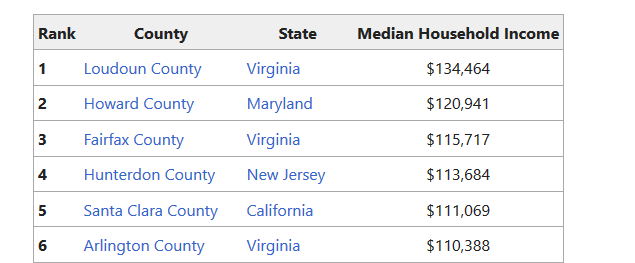On October 24, The Federal Times posted an article about relocating some of the Washington bureaucracy. What a great idea. We need to move some of the people in charge of government agencies closer to the people they are supposed to serve. We also need to break up the concentration of power that is the Washington swamp.
It is not a coincidence that many of the wealthiest counties in America are suburbs of Washington, D.C.
According to Wikipedia (a questionable source, but I suspect this is correct):
Presented below are the 25 highest-income counties (with populations of 65,000 or greater) in the United States by median household income according to the 2016 American Community Survey[4] prepared by the US Census Bureau. Five of the counties are located in the state of Maryland, five are in Virginia, four in California, three in New Jersey, two in New York, and one each in: Colorado, Georgia, Massachusetts, Ohio, Tennessee, and Texas. (Disclaimer: This only includes counties that participated in this single survey)
The Trump administration’s decision to move three agency components outside the Washington, D.C., metropolitan area has spurred a sizeable amount of controversy, but Sens. Josh Hawley, R-Mo., and Marsha Blackburn, R-Tenn., want to keep going with that trend.
The two senators introduced a bill Oct. 23 that would move about 90 percent of the workforce at the headquarters for 10 federal agencies to other states around the country and pop the “bubble” of D.C. federal employment.
“Every year Americans’ hard-earned tax dollars fund federal agencies that are mainly located in the D.C. bubble. That’s a big part of the problem with Washington: they’re too removed from the rest of America,” said Hawley in a news release.
“The HIRE Act will move policymakers directly into the communities they serve, creating thousands of jobs for local communities and saving taxpayers billions of dollars along the way.”
Under the proposal, the Department of Agriculture would move to Missouri, Commerce to Pennsylvania, Education to Tennessee, Energy to Kentucky, Health and Human Services to Indiana, Housing and Urban Development to Ohio, Interior to New Mexico, Labor to West Virginia, Transportation to Michigan and Veterans Affairs to South Carolina.
Obviously there are objections to this idea. The swamp is not enthusiastic about being split up!
The article concludes:
About 20 percent of D.C. residents are employed directly by the federal government, according to OPM and population data, while each of the 10 states slated for agency relocation under the bill have about .3 to one percent of their populations working for the federal government.
But Washington has an incredibly small population when compared with these states, and even if the entire D.C. federal workforce were to be relocated equally across the 10 states, the state with the lowest percent of federal workforce, Michigan, would only move from .3 percent to .4 percent.
The bill is bound to get strong pushback not only from the Democratically controlled House, which has been opposed to many of the Trump administration’s smaller moves, but also from the Virginia and Maryland members of Congress, whose states and districts would be likely to lose a number of jobs due to a relocation.
Relocation might also clear up the incredible traffic jam that is Washington, D.C. I suspect that it also would be cheaper to run government agencies in places where renting or owning office space would be considerably lower.
This will probably never happen, but it is a great idea.

